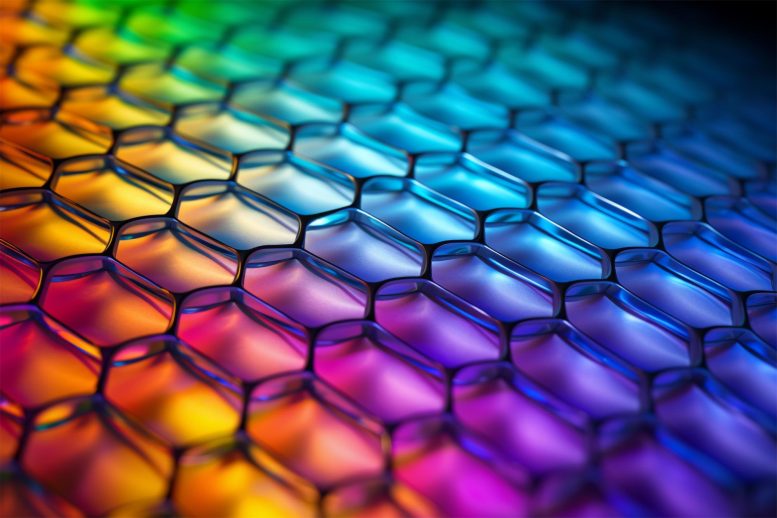
Researchers have utilized the rainbow scattering technique to effectively study the structure and imperfections of graphene, paving the way for more advanced studies of this versatile material.
New research uses protons to shine a light on the structure and imperfections of this two-dimensional wonder material.
Graphene is a two-dimensional wonder material that has been suggested for a wide range of applications in energy, technology, construction, and more since it was first isolated from graphite in 2004.
This single layer of carbon atoms is tough yet flexible, light but with high resistance, with graphene calculated to be 200 times more resistant than steel and five times lighter than aluminum.
Graphene may sound perfect, but it very literally is not. Isolated samples of this 2D allotrope aren’t perfectly flat, with its surface rippled. Graphene can also feature structural defects that can, in some cases, be deleterious to its function and, in other instances, can be essential to its chosen application. That means that the controlled implementation of defects could enable fine-tuning of the desired properties of two-dimensional crystals of graphene.
Insights From Rainbow Scattering on Graphene
In a new paper published in The European Physical Journal D (EPJ D), Milivoje Hadžijojić and Marko Ćosić, both of the Vinča Institute of Nuclear Sciences, University of Belgrade, Serbia, examine the rainbow scattering of photons passing through graphene and how it reveals the structure and imperfections of this wonder material.
While there are other ways of investigating the imperfections of graphene, these have drawbacks. For instance, Raman spectroscopy can not distinguish some defect types, while high-resolution transmission electron microscopy can characterize crystal structure defects with outstanding resolution, but the energetic electrons it uses can degrade the crystal lattice.
“The rainbow effect is not that rare in nature. It was discovered in scattering of the atoms and molecules as well. It was detected in ion scattering experiments on thin crystals. We have theoretically studied a scattering of low energy protons on graphene and demonstrated that rainbow effect occurs in this process as well,” Hadžijojić says. “Furthermore, we have shown that graphene structure and thermal vibrations could be studied via proton rainbow scattering effect.”
Using a process called rainbow scattering, the duo observed the diffraction they took as this passed through the graphene and the “rainbow” pattern created.
Characterizing the diffraction pattern, the researchers found perfect graphene gave a rainbow pattern in which the middle part was a single line with the inner part demonstrating a pattern with hexagonal symmetry, a symmetry that was absent in imperfect graphene.
The scientists also concluded that specific defect types produce their own distinct rainbow patterns, and this could be used in future research to identify and characterize defect types in a graphene sample.
Hadžijojić concluded, “Our approach is rather unique and could potentially serve as a useful complementary characterization technique of graphene and similar two-dimensional materials.”
Reference: “Study of graphene by proton rainbow scattering” by M. Hadžijojić and M. Ćosić, 30 May 2023, The European Physical Journal D.
DOI: 10.1140/epjd/s10053-023-00664-y




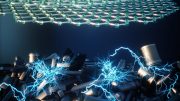
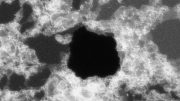
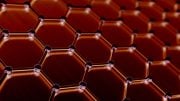
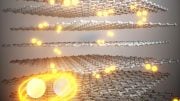
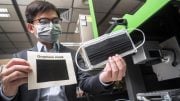
New research uses protons to shine a light on the structure and imperfections of this two-dimensional wonder material. Contrary to the fact, should we also consider using two-dimensional material interactions to shine a light on the structure and imperfections of protons.
There might be a way to make the mass-manufacturing of Graphene with that intense microwave induced ‘Flash’ method, that converts carbon monoxide or organic garbage into carbon that becomes deposited on a metal plate or steel roller assembly line. There was this “CSI Cyber” TV show episode, in which the heroes defused a booby-trapped time bomb in the big car they were speeding outside of a populated city with, not by figuring out which wire to cut, but by hot wiring the bomb’s battery to the running car’s alternator/generator, so that its strong ELECTRIC GROUNDING sucked all the juice out of the bomb’s battery, so that when the time was up, it couldn’t detonate. So, why not Hotwire the metal plate or roller that such ‘Flash’ Graphene is deposited upon, to the powerful grounding of a very big generator at a nearby electric power plant, to make this mass-manufacturing of Graphene far more efficient? Also, perhaps by charging the cloud of Carbon Monoxide or organic wastes, which is ‘Flashed’, zapped with powerful microwaves in this process, with electrostatic electricity first, could make this setup work even better. Also, a variation of this thing, might enable us to manufacture SUPER-STRONG combinations of Graphene and metals, by intermittent coatings of NANOPARTICLES of metals, adhered to the Graphene in flakes, and using ‘Cold-Welding’, to make the metal Nanoparticles weld together, without metal-melting heat, which carbon structures like Graphene are incinerated by, and when it sets, apply another coat of flaky Graphene, and once that cools down, more metal Nanoparticles, using electrostatic effects to ‘paint’ them evenly, Cold-weld them into another coating intermixed with Graphene flakes and the metal the previous layer, and repeat, until you have a composite Graphene/Metal material, with the Graphene acting like the rebars in concrete to strengthen it, that will be nearly indestructible. Trouble is, making this thing would be very time consuming, and also very energy-consuming, although ‘Painting’ this composite material, might be expedited by using Carbon Nanotubes, beside Graphene. Something like this could be manufactured in the International Space Station, because the zero gravity up there would help the electrostatic coating of Nanoparticles or Nanotubes be more precise, they could get electricity from solar panels, and the SUPERCOLD temperatures needed to make the metal Nanoparticles weld together with extreme cold instead of heat, could be provided by a setup that exploits the near-absolute zero coldness of outer space, in the shady side of the ISS. And that’s what you build the Starship ENTERPRISE out of ! EOJ